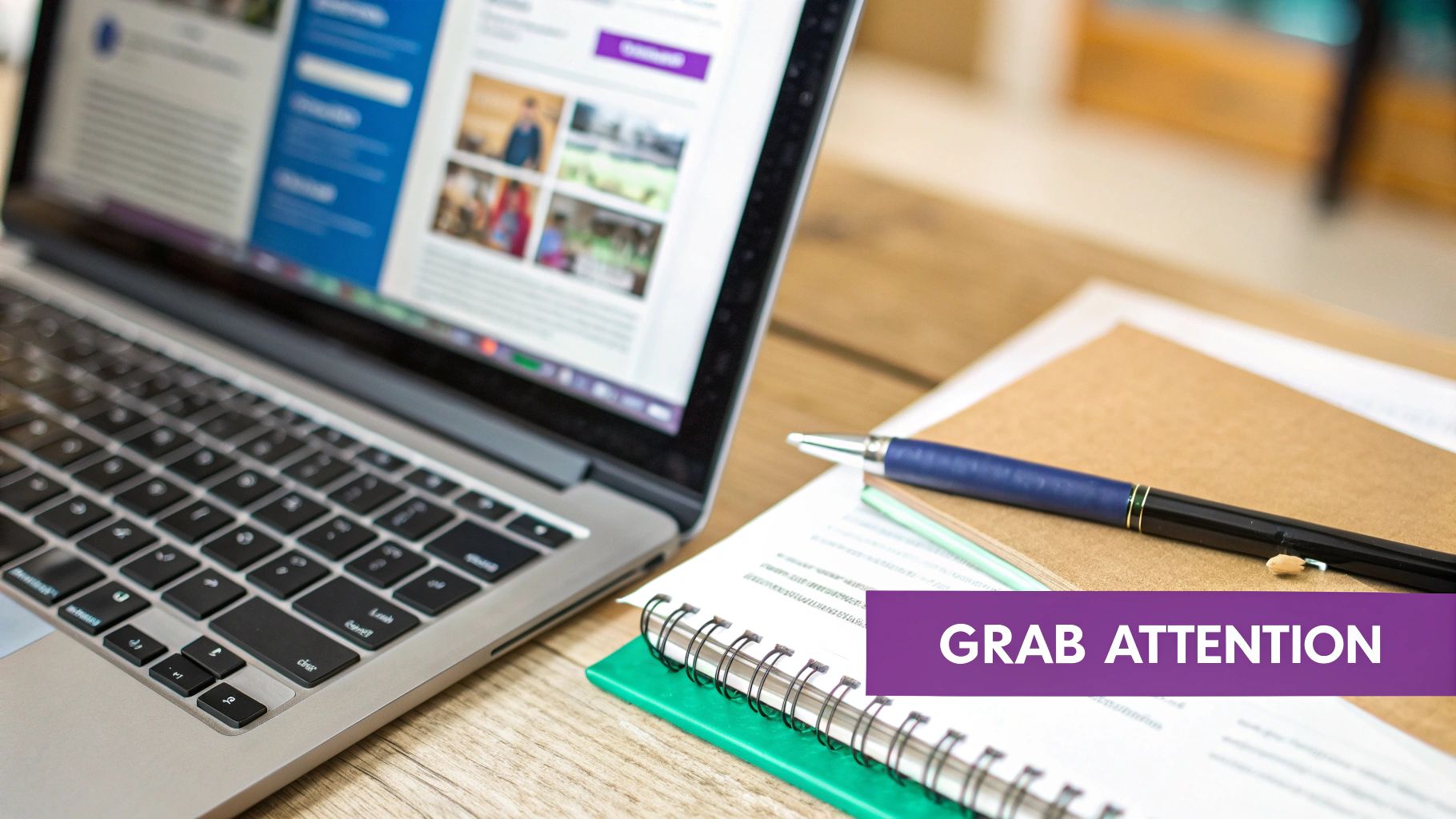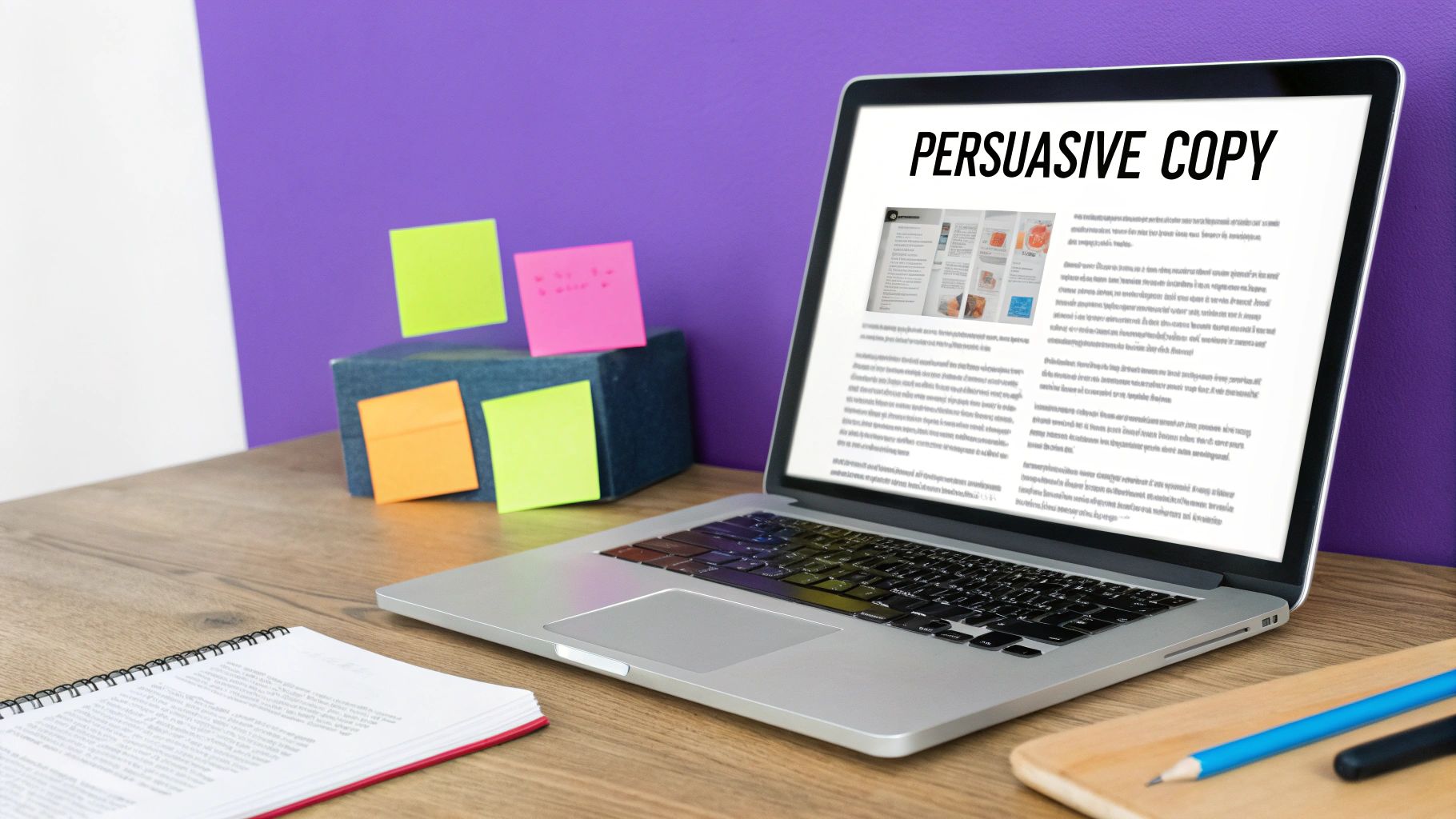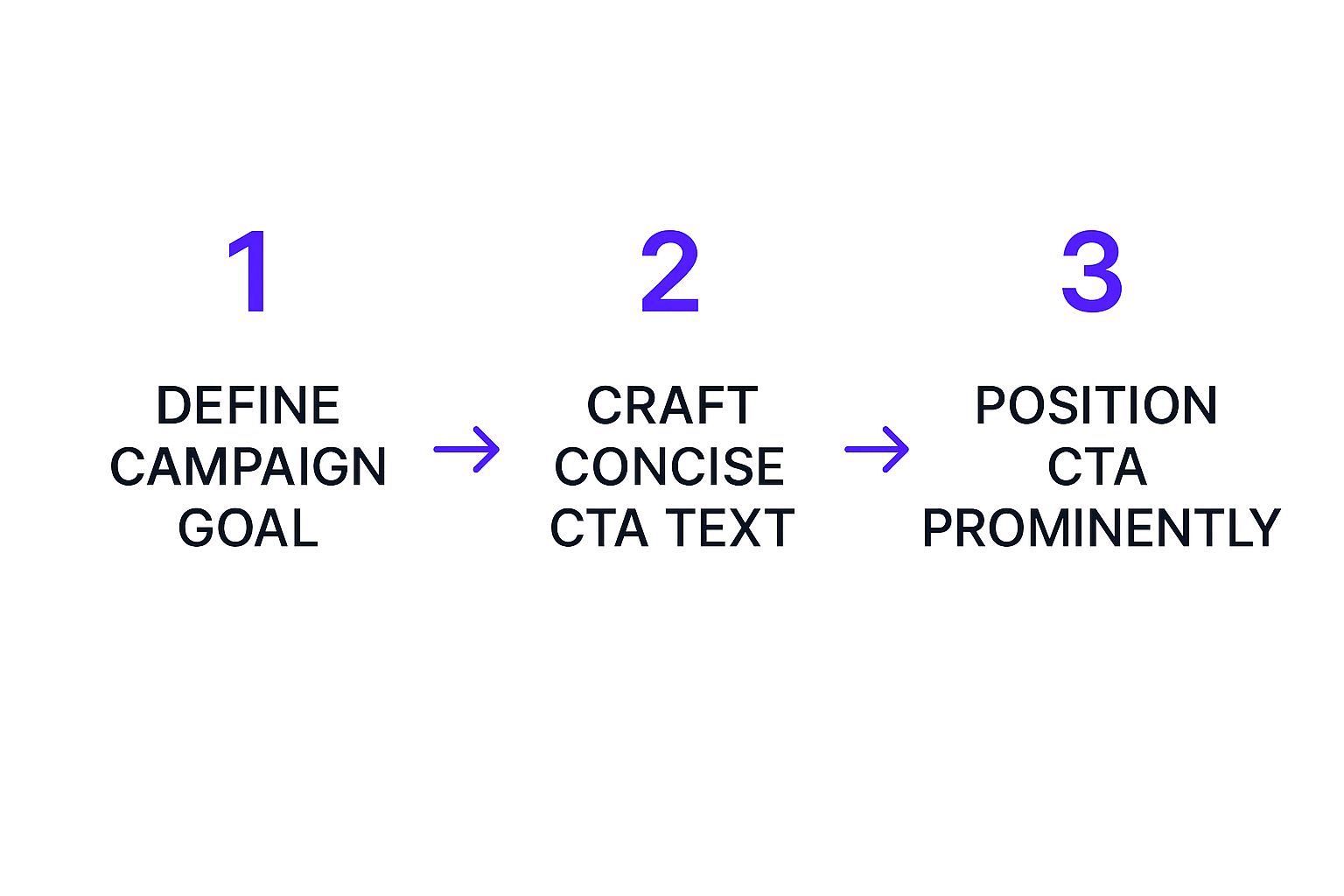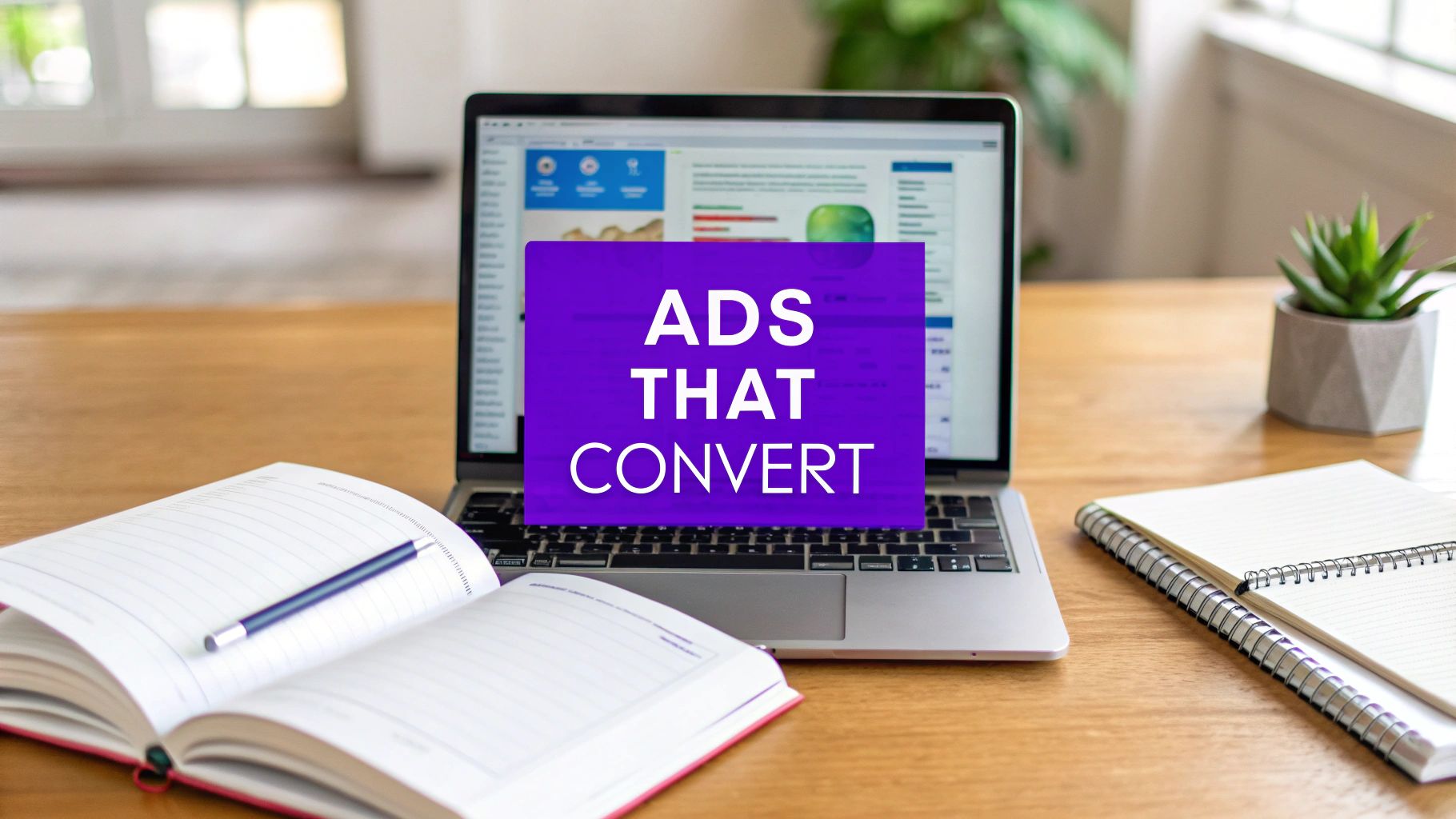Mastering Facebook Ads Copywriting for Conversions
Let's be real for a second: most Facebook ad copy is completely forgettable. It flashes past in a blur of generic claims and half-hearted promises, failing to make a dent. With millions of businesses all screaming for attention, "good enough" copy is a guaranteed way to burn through your ad budget with nothing to show for it.
The sheer scale of the platform is mind-boggling. We're talking over 3 billion monthly active users and an ad machine that raked in about $131.9 billion in 2023. The opportunity is huge, but so is the competition. That's where exceptional copywriting becomes your secret weapon.
The Disconnect Between Brand and Buyer
One of the biggest reasons ads fall flat is a fundamental disconnect. Too many businesses write from their own perspective, rambling on about features, company awards, and internal jargon. They talk at their audience instead of with them.
The core mistake is treating your ad like a broadcast instead of a conversation starter. Your audience doesn't care about your product's features; they care about how those features solve their specific, nagging problems.
For example, a company selling project management software might brag about its "Gantt chart functionality." A potential customer, however, is just thinking, "I need to stop missing deadlines and stressing out my team." The winning ad copy connects those two worlds by translating the feature into a real-life benefit: "Tired of missed deadlines? Our visual timelines keep your entire team on track, guaranteed."
The Problem of Vague Messaging
Another common trap is ambiguity. Weak hooks, fuzzy benefits, and unclear calls-to-action (CTAs) leave people confused about what you’re offering and what they're supposed to do next.
- Weak Hook: "Check out our new marketing tool." (Why should I? What does it do?)
- Unclear Benefit: "Our software is innovative." (Says who? How does that help me?)
- Fuzzy CTA: "Learn more." (Lacks urgency and feels like a chore.)
Effective Facebook ads copywriting is brutally precise. It uses sharp, clear language that leaves no room for guesswork. Instead of a lazy "Learn more," a much stronger CTA would be "Get Your Free 5-Step Marketing Plan." It's specific and instantly communicates the value waiting on the other side of the click. Getting a handle on the broader world of social media ads shows you just how critical this kind of clarity is on every platform, not just Facebook.
We see these mistakes constantly. To help you sidestep them, here’s a quick rundown of the most common pitfalls and how to fix them on the spot.
Common Ad Copy Pitfalls and Their Solutions
| Feature-Dumping | You're listing what your product has, not what it does for the customer. People buy solutions, not specs. | Translate every feature into a clear benefit. Instead of "10GB of storage," say "Never run out of space for your memories again." |
|---|---|---|
| Corporate Jargon | Using industry-speak like "synergistic solutions" or "paradigm shift" alienates 99% of your audience. | Write like you talk. Use simple, direct language that a real human would understand. If your mom wouldn't get it, rewrite it. |
| Vague Promises | Statements like "Boost your ROI" or "Improve your life" are meaningless without specifics. | Get concrete. Use numbers, testimonials, or specific outcomes. "Our users see a 37% increase in sales in the first 90 days." |
| Weak Call-to-Action | "Click here" or "Learn more" are passive and uninspiring. They don't create urgency or excitement. | Be specific and value-driven. Try "Download Your Free Guide Now" or "Claim Your 50% Off Coupon Before It's Gone." |
At the end of the day, ads fail when they're self-serving, confusing, or just plain boring. To win, you have to shift your focus entirely—from what you want to sell to what your customer desperately needs to solve. That mindset change is the first and most critical step toward writing copy that doesn't just get noticed, but actually gets results.
Your Audience Research Blueprint for Ad Copy

Let's kill a myth right now: killer Facebook ads copywriting doesn't start with a brilliant idea that strikes you in the shower. It starts with listening. Hard.
The most powerful ads don't feel like marketing at all. They feel like a direct answer to a question your customer was just thinking. That’s not a magic trick—it’s the result of rolling up your sleeves and doing the research.
So, forget guessing what your audience wants. Your job is to uncover their exact pain points, their secret desires, and—most importantly—the exact language they use to talk about them. When you can echo their own thoughts back at them, you build an instant connection that generic copy just can’t touch. This is about gathering raw intel to build a message that hits them right where they live.
Dig for Gold in Your Own Backyard
Your current customers are a walking, talking swipe file of copywriting genius. Seriously. They've already picked you for a reason, and their feedback is littered with the exact words you need to attract thousands more just like them.
Your first move is to find the patterns in what real people are saying. Look for the phrases they repeat, the problems they say you solved, and the benefits they can't stop talking about. These are the raw materials for ads that actually convert.
Go hunting in these places:
- Customer Reviews: Scour your product pages, Yelp, Google—anywhere people leave feedback. What words do happy customers use to describe life after your product? What pains did they mention from their life before you?
- Support Tickets & Live Chats: Your customer service team is sitting on a goldmine. Read through support chats and emails to find common questions, frustrations, and points of confusion. These are the objections your ad copy must demolish.
- Surveys & Testimonials: Don't be afraid to just ask your best customers what they love. A simple survey asking, "What almost stopped you from buying?" can reveal the exact hesitations you need to crush in your ads.
Spy on Your Competitors (Legally, of Course)
Your competitors are already spending a ton of money to figure out what works. You can learn from their wins and their blunders without spending a single dollar of your own budget. The goal here isn't to copy them—it's to understand their angles and find the gaps they've missed.
Fire up the Facebook Ad Library. It's free, powerful, and lets you see every ad your competitors are running right now. As you browse, don't just glance at the ads. Dissect them.
Pay extra close attention to the comments section on their most popular ads. This is where you find the raw, unfiltered customer feedback. You'll see the objections, questions, and confusion that the ad copy failed to address.
As you do your recon, build a simple swipe file. For each ad, make a note of:
- The Hook: How do they grab attention in that first sentence? Is it a question? A bold claim? A shocking stat?
- The Core Angle: Are they hammering a pain point ("Tired of wasting time on X?") or selling a dream ("Finally achieve Y!")?
- The Call-to-Action (CTA): What are they asking people to do? Is it a boring "Shop Now," or something with a little more spice?
Map Your Customer's Mind
Okay, you've gathered a mountain of raw data. Now it's time to turn that chaos into a weapon. A customer message map is a simple document that translates your research into clear, actionable copywriting angles. It’s the tool that keeps your ads rooted in real customer insights, not just your own best guesses.
Think of this map as your strategic playbook for every ad you write from here on out.
It should have a few key columns to organize everything you've learned.
| "I'm overwhelmed by my to-do list." | Feel organized and in control. | "It felt like I was drowning." | "Feeling like you're drowning in tasks?" |
|---|---|---|---|
| "Our team keeps missing deadlines." | Improve team productivity and reduce stress. | "Communication is a mess." | "Is messy communication killing your deadlines?" |
| "I don't know where my money is going." | Gain financial clarity and save more. | "I need a simple way to track everything." | "Finally, a simple way to track where every dollar goes." |
This mapping process is the heart and soul of smart targeting. To get even more granular, you can explore different customer segmentation strategies to tailor these messages to hyper-specific groups.
When you do this homework upfront, you stop gambling with your ad copy and start engineering it to win.
Crafting Irresistible Hooks and Powerful Headlines

You've got about three seconds. Maybe less. That's the entire window you get to stop someone from scrolling right past your ad into the digital abyss.
In the blink-and-you-miss-it world of the Facebook feed, your headline and the very first line of your ad—the hook—aren't just important. They're everything. This is where the battle for attention is won or lost.
A killer hook doesn't sell your product; it sells the next three seconds of the reader's time. Its only job is to be so magnetic, so relevant, that it physically forces them to pause and read the next line. Without that, the rest of your brilliant facebook ads copywriting might as well be invisible.
This is the most critical real estate in your entire ad. Getting it right is the difference between a click and a scroll.
Winning on Mobile with Extreme Brevity
Before we get into specific formulas, let's talk about the elephant in the room: mobile. Most people will see your ad on a tiny screen, often with the text cut off after just a few lines. This makes brevity your absolute best friend.
Recent data drives this point home perfectly. An analysis projected for 2025 shows that Facebook ads with copy between 1 and 15 words perform roughly 50% better than their longer, wordier cousins. That isn't a small lift—it's a massive signal that short, punchy messages win the game. If you want to dive deeper into the numbers, check out this in-depth analysis on Blogging Wizard.
Your goal is simple: pack the maximum amount of impact into the minimum number of words. Every single word in your headline and hook has to earn its spot.
Proven Formulas for Scroll-Stopping Headlines
Look, you don't need to reinvent the wheel every time you sit down to write an ad. Proven copywriting formulas work because they tap directly into fundamental human psychology. The real trick is knowing which one to pull out of your toolbox for your specific audience and goal.
Here are a few powerhouse frameworks to get you started:
- Problem-Agitate-Solve (PAS): This is a classic for a reason. You start by calling out a problem your audience feels deep in their bones, stir the pot by describing the frustration it causes, and then swoop in with your product as the obvious hero.
- Example (for a meal delivery service): "Hate wasting your Sunday meal prepping? (Problem) Just to eat the same bland, boring lunches all week? (Agitate) Get fresh, chef-made meals delivered and take back your weekend." (Solve)
- Curiosity-Driven Questions: Humans are nosy creatures. If you pose a question that your target audience is dying to know the answer to, you've got them. It's an incredibly effective way to stop the scroll in its tracks.
- Example (for a financial advisor): "Do you know the #1 mistake most people make with their retirement savings?"
The best hooks create an "information gap." You dangle a piece of a puzzle that the reader feels an almost physical need to complete by clicking your ad.
- Bold Statements & Contrarian Takes: Make a surprising claim that goes against a common belief in your industry. This instantly makes you look like an authority and makes people lean in to hear what you have to say next.
- Example (for a fitness coach): "Why hours of cardio is actually sabotaging your weight loss."
Matching the Hook to Audience Awareness
The formula you pick needs to line up with how aware your audience is of their problem and your solution. A rookie mistake is throwing the wrong kind of hook at the wrong temperature of traffic—like pitching a sale to someone who doesn't even know they have a problem.
To create ads that really land, you have to meet people where they are. And to learn more about dialing in your campaigns, check out our guide covering some of the best practices for Facebook ads that actually work.
Let's break it down.
| Problem Aware | They know they have a problem but don't know solutions exist. | Use PAS to validate their pain and introduce a whole new category of solution. |
|---|---|---|
| Solution Aware | They know solutions exist but don't know about your product. | Use curiosity or a bold statement to introduce your unique way of solving the problem. |
| Product Aware | They know about your product but haven't pulled the trigger yet. | Use direct offers, social proof ("See why 5,000+ people love..."), or scarcity. |
By aligning your headline with your audience's mindset, you stop shouting into the void and start having a relevant conversation. This one small shift is the secret to writing hooks that don't just grab attention—they prime the perfect person to convert.
Writing Body Copy That Persuades and Converts

Alright, your hook did its job—it stopped the scroll. But now the real work begins.
The body copy is where you pivot from grabbing attention to earning trust. It’s your chance to make a compelling case for your offer, quiet the skeptic in their head, and guide them smoothly toward that click.
Every single sentence has a job. If it isn't building desire, answering a silent question, or nudging them closer to your call-to-action, it’s dead weight. Cut it. Great Facebook ads copywriting is ruthlessly efficient and laser-focused on the user.
From Features to Feelings
This is one of the most common—and costly—mistakes I see: "feature-dumping." You might be incredibly proud of your product’s 12-speed motor or proprietary algorithm, but your customer doesn't care about the specs. Not really.
They care about what it does for them. Your job is to translate every feature into a tangible, emotional benefit.
Think of it like this: a feature is what your product is. A benefit is what your customer becomes after using it.
- Feature: Our CRM integrates with your email.
- Benefit: Stop switching between a dozen tabs. Manage every customer conversation in one place and win back an hour every single day.
- Feature: Our shoes have memory foam insoles.
- Benefit: Walk for hours without that searing foot pain that cuts your day short.
See the difference? This simple shift turns a boring product description into a vivid picture of a better life.
Make Your Copy Easy to Read
Here’s a hard truth: people don't read ads on Facebook. They scan them. Your copy has to be visually digestible, especially on a tiny mobile screen. Dense paragraphs are the enemy.
Break up your text to make it inviting and easy to skim. Your reader should be able to get the gist of your offer in just a few seconds without having to read every single word.
Here are a few simple ways to make your copy more scannable:
- Use ultra-short paragraphs: Seriously, stick to one or two sentences. This creates white space that makes the text feel less like a chore to read.
- Lean on bullet points: Use checkmarks (✅) or other emojis to list key benefits or outcomes. It’s the perfect format for highlighting the most important takeaways.
- Bold key phrases: Draw the eye to the most powerful parts of your message, like a key benefit or a time-sensitive offer.
If you want to really sharpen your skills, there are some great frameworks out there that can help you create killer ad copy when you're in a pinch.
Address Objections Before They Arise
Your potential customers are skeptical. They've been burned by empty promises before. Your body copy is the perfect place to preemptively tackle their fears and doubts, building trust in the process.
Put yourself in their shoes. What questions are swirling in their minds? Is this too expensive? Will it be a pain to set up? What if it doesn't work for me?
Tackle these head-on. For instance, if you sell a high-ticket item, you could add a line like, "And with our flexible payment plan, you can get started for less than your daily coffee." If your product seems complex, try, "You’ll be set up in under 5 minutes, no tech skills required."
By actively reassuring customers and addressing their fears, you can dramatically boost results. This trust-building approach has been shown to increase landing page conversions by up to 80%. It's clear proof that empathy in your copy is directly tied to performance.
Craft a Call-to-Action That Demands a Click
Finally, you have to tell people exactly what to do next. A weak, generic call-to-action (CTA) like "Learn More" can kill all the momentum you’ve built.
Your CTA should be specific, urgent, and packed with value. Instead of a passive suggestion, make it an active command that reinforces the benefit they're about to receive.
| Learn More | Get Your Free Marketing Plan |
|---|---|
| Shop Now | Claim Your 50% Off Coupon |
| Sign Up | Start Your Free 14-Day Trial |
The button text itself is limited, but the final line of copy leading into it can amplify the urgency and value. A phrase like, "Click 'Sign Up' to get instant access before this offer expires," connects the action to the immediate reward. It leaves no doubt in their mind about what to do next and why they should do it right now.
Testing and Optimizing Your Ad Copy for Better ROI
Great Facebook ads copywriting isn't written on the first try—it's discovered through relentless testing. A lot of advertisers throw copy at the wall, hoping something sticks. That's a fast way to burn through your budget and come away with nothing but frustration.
The pros, on the other hand, treat their ad spend like a research budget. Every dollar spent buys them valuable data. This data then fuels the next ad, and the next, creating a powerful feedback loop that consistently cranks out winners. You don't need a massive budget for this, just a smart process.
Setting Up Meaningful A/B Tests
Forget guesswork. A/B testing (or split testing) lets you prove what actually works using cold, hard data.
But there's a catch: you have to test one variable at a time. If you change the headline, the body copy, and the CTA all at once, you’ll have no clue which change actually moved the needle. Was it the clever headline? The emotional story? The new button text? Who knows.
Focus your tests on the elements that deliver the biggest punch first. Here are a few ideas to get you started:
- Headlines: Test a benefit-driven headline (“Get Flawless Skin in 30 Days”) against one that sparks curiosity (“The Skincare Mistake 90% of People Make”).
- Hooks: Pit a short, punchy first line against a slightly longer, more storytelling-based intro. See what grabs your audience by the collar.
- Calls-to-Action (CTAs): Compare a direct CTA like "Shop Now" against a value-focused one like "Get 50% Off Today." Sometimes a small tweak here makes all the difference.
- Ad Angles: Run a pain-point-focused ad (e.g., "Tired of wasting money on ads that don't work?") against a desire-focused ad (e.g., "Imagine getting 5 new clients this week.").
By isolating a single variable, you get clear, actionable insights. Once you find a winning headline, that becomes your new "control" version. Then, you start testing body copy variations against it. This cycle of continuous improvement is how you build killer ads.
The Metrics That Actually Matter
Vanity metrics like likes and shares feel nice, but they don't pay the bills. When you’re optimizing copy, you need to zoom in on the data points that directly impact your bottom line.
The most successful advertisers are ruthless about focusing on performance indicators. They know that a high click-through rate means nothing if those clicks don't turn into customers.
Your entire world should revolve around these two metrics:
Click-Through Rate (CTR): This tells you how good your copy is at grabbing attention and getting someone to stop their scroll. A low CTR is almost always the first sign that your hook or headline is falling flat.
Conversion Rate: This is the big one—the percentage of people who take the action you want (buy something, fill out a form) after clicking your ad. This metric tells you if your copy is persuading the right people to click.
Ultimately, to get a full picture of your campaign's health, you have to understand how to calculate your return on ad spend. This is the true north of your advertising efforts—the ultimate measure of whether your copywriting is actually making you money.
This infographic breaks down a simple, effective flow for crafting copy that gets people to act.

As you can see, every element has to work in harmony, from the campaign's core goal right down to the CTA, guiding the user seamlessly toward that final click.
Creating a Simple Testing Matrix
If you're not tracking your tests, you're not learning. Staying organized is the secret weapon here. A simple spreadsheet is all you need to create a testing matrix that keeps you honest and ensures you're building on your wins.
Below is a sample matrix to help you organize your A/B tests and track what's working.
Ad Copy A/B Testing Matrix
| Headline | "Get 50% Off Our #1 Bestseller" | "Why 5,000+ Customers Love This" | 2.1% | 3.4% |
|---|---|---|---|---|
| Body Copy | Benefit-focused list | Short customer story | 3.4% | 4.2% |
| CTA | "Shop Now" | "Claim Your Discount" | 4.2% | 4.1% |
This structured approach transforms your advertising from a guessing game into a scientific process. You're not just running ads; you're building a library of proven copy elements that you can use to scale your results and maximize your return. This kind of optimization is more crucial than ever. Projections for 2025 show that 77% of marketers view Facebook Ads as their most effective tool, largely thanks to its precision and cost-efficiency, with average costs per click sitting around $0.77 for traffic ads.
Burning Questions About Facebook Ad Copy
Even when you've got your strategy nailed down, little questions always creep in when you’re actually in the trenches writing ads. Getting solid answers to these common sticking points can be the difference between a campaign that takes off and one that just… doesn't.
This section tackles the most frequent questions we hear about Facebook ads copywriting. Think of it as your field guide for clearing those hurdles that slow you down.
What’s the Perfect Length for Facebook Ad Copy?
Everyone wants a magic number, but there isn't one. The best rule of thumb is as long as it needs to be, but as short as humanly possible.
For most ads, especially on mobile where attention spans are fleeting, shorter is better. Try to keep your primary text around 125 characters. This ensures your main point hits home without anyone needing to tap "See more."
But that’s not a hard-and-fast rule. If you're selling something complex or high-ticket, you'll need more runway to build trust and dismantle objections. In those cases, longer, story-driven copy can absolutely crush it.
The only way to know for sure is to test both:
- Short & Punchy: Get straight to the point. No fluff.
- Long & Detailed: Tell a story, build a case, and handle every objection.
Let your A/B test data be the judge. Your audience will tell you what they prefer.
How Important Is Brand Voice, Really?
It’s everything. Your Facebook feed is a chaotic mess of millions of advertisers all screaming for attention. A distinct brand voice is what makes you stand out from the noise. If your ads sound like they were written by a corporate robot, they’ll just blend in.
Think about the brands you actually remember. Duolingo is playful and a little bit unhinged. Nike is all about inspiration and empowerment. Their ad copy sounds like them, and it creates an instant vibe with their audience.
Forget about just sounding "professional." That's the bare minimum. Instead, define your brand’s personality. Are you witty? Empathetic? A straight-shooting authority? Inject that flavor into every single headline you write.
This isn’t just about one ad; it’s about building recognition over time. When people see your ad, it should feel like hearing from a familiar friend, not a faceless company.
Can I Use Emojis in My Ad Copy?
Yes, and you probably should—if you're smart about it. When used right, emojis are a secret weapon in Facebook ad copy.
Here’s why they work:
They Stop the Scroll: A pop of color in a sea of text is hard to ignore.
They Make It Scannable: Using emojis like ✅, 👉, or 🎯 as bullet points breaks up text and makes your benefits easy to digest at a glance.
They Pack an Emotional Punch: Sometimes an emoji says it all. A 😩 can convey frustration way faster than a full sentence can.
The key is not to go overboard. A dozen emojis in a row looks spammy and desperate. Use one or two strategically to add some visual flair and emphasize your key points. And always make sure they match your brand voice. A high-end law firm and a trendy DTC fashion brand will have very different emoji playbooks.
How Do I Deal with Facebook Ad Policy Problems?
Navigating Facebook's ad policies feels like trying to read a map that changes every week. The best defense is a good offense: get familiar with the rules before you start writing. Stay away from exaggerated claims, words that trigger sensitive topics (like anything related to personal attributes), and you'll sidestep most issues.
If your ad gets rejected, don't panic. First, read the rejection reason they give you. It's often a simple fix—maybe you used a forbidden word or made a claim that was a little too bold. Just edit the copy to be compliant and resubmit it.
There's a reason marketers stick with the platform despite the headaches. Conversion rates on Facebook are strong, averaging 8.78% across industries. In fact, 40% of marketers say Facebook is one of their top three sources for ROI, proving its power to drive real business growth. You can dig into more numbers with these Facebook ad performance statistics on Helixbeat.
Ready to stop guessing and start getting real results from your paid social campaigns? The expert team at Rebus has managed over $100 million in ad spend, crafting strategies that captivate, engage, and convert. Partner with us to transform your brand’s potential into measurable success. https://rebusadvertising.com
